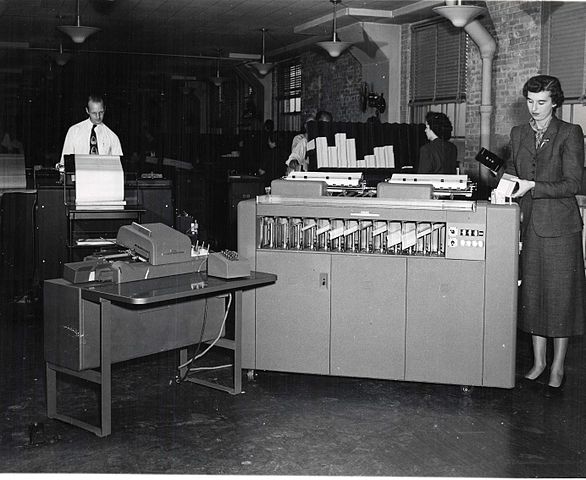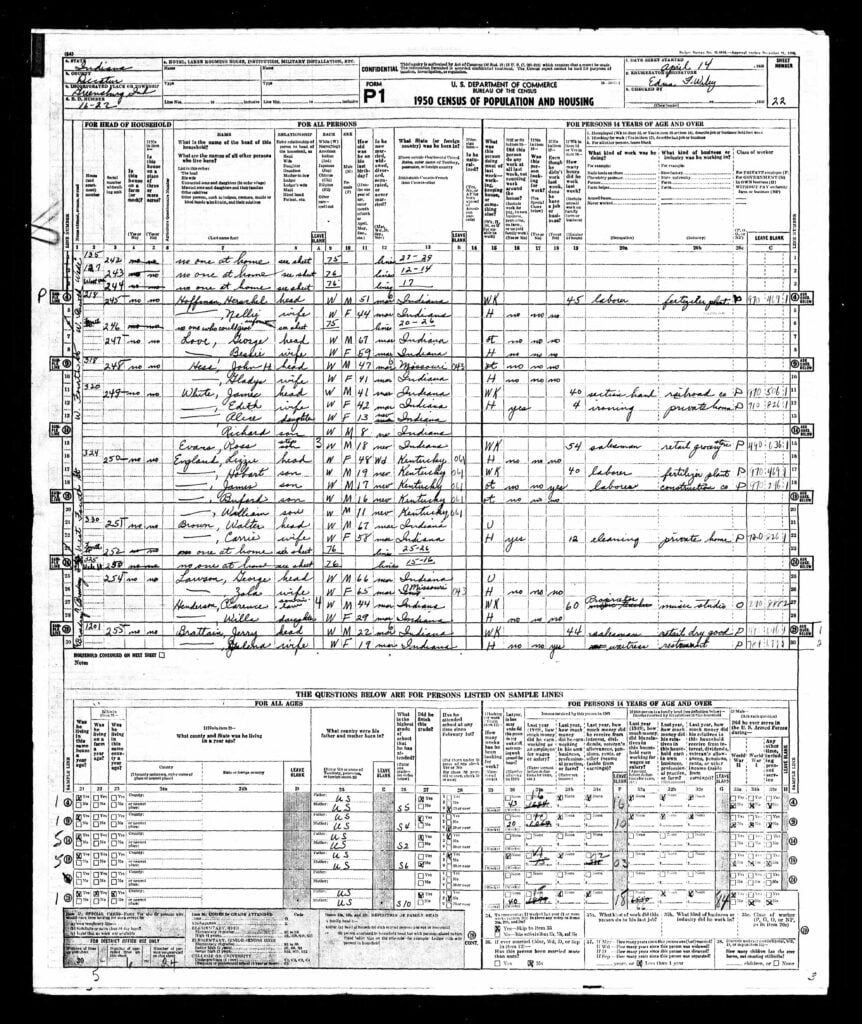How AI is Revolutionizing Family History Research

Picture this: it’s 1950, and census takers are knocking on doors across America, gathering information about every person living in the country. They’re asking questions like, “What’s your name? How old are you? What do you do for a living?” These details paint a vivid picture of American life in the mid-20th century.
Fast forward to today, and this data is a goldmine for anyone interested in exploring their family history, researching social trends, or understanding how our nation has evolved. But there’s a catch: without an index, finding specific information in the census records is like searching for a needle in a haystack.
That’s where indexing comes in! By creating a searchable database of all the names, ages, and other details in the census, we can unlock the full potential of this incredible resource. Imagine being able to type in your great-grandparents’ names and instantly discover where they lived, what they did for a living, and who their neighbors were.
But indexing the 1950 Census is no small feat. We’re talking about millions of handwritten records that need to be carefully transcribed and organized. Laryn Brown, Storied’s VP of Content Operations, recalled when the previous two censuses were released. “When 1930 came out, it was one of the very first big record sets to be put online. It took forever to get everything online. It was released one state at a time and took at least a year to finish. When 1940 came out, it was a little faster but still the same process. When the 1950 Census was released, artificial intelligence and machine learning changed everything.”
By harnessing cutting-edge AI technology, Storied set out to create an independent index of the 1950 Census for anyone interested in exploring their family history from this pivotal mid-20th century period.
An Overview of the Process
The development of a handwriting recognition system was an intensive process spanning approximately two years. Once the system was in place, Storied was able to complete both the 1950 and 1930 Census collections in less than six months. Here’s an overview of the steps involved in the 1950 Census project at Storied:
- The National Archives and Records Administration (NARA) supplied the digital images of the 1950 Census, organized by county and state.
- Handwriting recognition technology was employed to extract information from the headers, such as the enumeration location.
- A unique AI model was developed for each type of item listed in the census.
- This process involved “segmentation,” where the images were divided into numerous small files so each piece of data could be individually analyzed by the AI.
- After processing, these fragments were reassembled to reconstruct the original census.
- To standardize the data, it was compared against a database for fields like location, relationship status, gender, race, age, and marital status. For instance, over 90,000 locations for birthplaces were normalized.
- The final stages included developing a search interface and creating an index to make the census data searchable.

AI 101: An Introduction
Are you curious about how computers can understand handwriting, learn from data, and mimic human intelligence? Let’s explore these topics to learn more about what they are, how they work, and how these powerful tools are revolutionizing the way we work in family history.
Handwriting Recognition
Handwriting recognition is a type of technology that allows computers to interpret and understand human handwriting as text. This can include anything from individual characters to whole sentences written in cursive or print. The technology works by analyzing the shapes and patterns of the handwritten notes using algorithms and converting them into digital text that the computer can process. This is particularly useful for digitizing handwritten documents, like the census. Handwriting recognition systems can vary in their accuracy and may need to be trained to recognize specific handwriting styles, but advancements in artificial intelligence and machine learning have significantly improved their ability to understand a wide range of handwriting types.
Machine Learning
Machine learning is a branch of artificial intelligence that focuses on creating computer programs that can learn and improve their performance on a specific task without being explicitly programmed. Instead of following a set of predefined rules, machine learning algorithms analyze vast amounts of data to identify patterns and build mathematical models that can make predictions or decisions.
These algorithms learn from experience, much like humans do, by adjusting their internal parameters based on the input data and the desired output. For example, a machine learning system could be trained on a large dataset of labeled images to recognize and classify objects in new images it hasn’t seen before. As the algorithm processes more data, it becomes better at making accurate predictions.
Creating an AI Model
Creating an AI (Artificial Intelligence) model involves developing a computational system that can perform tasks usually requiring human intelligence. These tasks could range from recognizing speech or images, understanding and generating human language, making decisions, or predicting future events based on past data.
The process begins with selecting and preparing a dataset, which is a collection of data relevant to the task the AI is meant to perform. This data is then used to train the AI model, allowing it to learn patterns, relationships, and characteristics from the data. The training involves algorithms—set rules and procedures the model follows—to process the data and make inferences or predictions. After training, the model is tested and refined until it achieves the desired level of accuracy.
Essentially, creating an AI model is like teaching a computer system to understand and interact with the world in a way that mimics human cognition but at a potentially much larger scale and speed.
Benefits of Using AI

Utilizing AI to index the 1950 census presents an opportunity to streamline and enhance the accessibility of historical data. Traditionally, indexing vast archives like the census requires extensive human effort and time, often taking years to complete due to the meticulous need to transcribe, categorize, and validate every entry manually. The introduction of AI in this process revolutionizes it by significantly accelerating the time to market. AI algorithms can work around the clock without fatigue, processing and organizing millions of records at a pace no human team can match. This rapid processing means that the valuable insights and genealogical information contained within the 1950 census can be made available to researchers, historians, and the public much sooner than previously possible.
Plus, the cost savings associated with deploying AI for such tasks are substantial. Human labor is not only slower but also more expensive compared to AI, especially for large-scale data projects like census indexing. AI can analyze and index data with minimal ongoing costs, reducing the financial burden on institutions or organizations undertaking the project. Additionally, AI technologies can improve over time, learning from errors and enhancing their accuracy, further reducing the need for costly manual checks and corrections. By lowering operational costs and reducing time frames, AI enables a more efficient and economical approach to unlocking the historical wealth of information contained in the 1950 census, making it a highly beneficial tool for historical documentation and research.
What About the Accuracy of Using AI?
Handwriting recognition technology has made significant strides in recent years, achieving impressive accuracy rates. However, it’s important to acknowledge that the accuracy of handwriting recognition is not perfect and typically falls between 80-85%. This means that out of every 100 words transcribed by the AI, about 15-20 words may contain errors. In comparison, human indexers generally achieve an accuracy rate of 90-95%, which is slightly higher than the AI’s performance. Despite this accuracy gap, AI-powered indexing offers several advantages that can help mitigate the impact of errors.
One approach to address potential inaccuracies in AI-generated indexing is to employ a combination of exact match and phonetic matching techniques. Exact matching requires the search query to match the indexed text precisely, while phonetic matching allows for some flexibility by considering words that sound similar. By incorporating both methods, the system can catch and correct some of the errors introduced by the AI. For example, if the AI misinterprets a handwritten name as “Smyth” instead of “Smith,” a phonetic search for “Smith” would still yield the correct result.
Additionally, allowing users to make corrections to the indexed data can further enhance the accuracy over time. As more people search the census records and provide feedback on any errors they encounter, the index can be continuously refined and improved. This crowdsourcing approach leverages the collective knowledge and efforts of the user community to gradually increase the accuracy of the AI-generated index.
Why Should I Use Storied’s 1950 Census Index?
There are currently only two indexed versions of the 1950 Census available that include more than just name data. The first index was created through a collaborative effort between FamilySearch, Ancestry, and MyHeritage. Storied independently produced the second index. Having two separate indexes of the 1950 Census offers several advantages for researchers and genealogists.

The primary benefit of having two distinct indexes is that they are likely to contain different errors. An error present in one index may not exist in the other, and conversely, an error in the second index may not be found in the first. This variation in errors can be attributed to differences in the indexing processes, algorithms, and quality control measures employed by each organization. By having access to both indexes, researchers can cross-reference the information and identify discrepancies, leading to more accurate and comprehensive results.
Moreover, any experienced researcher will advise using all available resources when conducting genealogical or historical research. Each index may have its strengths and weaknesses, and by utilizing both, researchers can maximize their chances of finding the information they seek. One index may have better coverage of certain regions, while the other may have more accurate transcriptions of names or addresses. By exploring both indexes, researchers can fill in gaps and uncover details that might have been missed if relying on a single source.
Conclusion
The leap from collecting census details by hand in 1950 to using AI for digital indexing is like stepping into a time machine that brings history right to our fingertips. Thanks to efforts like Storied’s project, digging into family histories has never been easier or more exciting. It’s amazing to see how technology, especially AI, is changing the game, making it super quick to find out about our ancestors’ lives without sifting through mountains of paper. This shift is a big deal for anyone curious about their roots, showing us the power of tech to open up the past in ways we could only dream of before. As we keep improving these tools, who knows what other family secrets and stories we’ll be able to uncover? It’s a thrilling time for anyone looking to connect with their family’s past.
Want to Learn More About the 1950 Census?
If you’re interested in learning more about the 1950 Census and exploring additional resources, be sure to check out the official websites of the United States Census Bureau and the National Archives and Records Administration (NARA). These sites offer a wealth of information, including historical overviews, access to census records, and helpful genealogy series.
Additionally, various articles and blog posts provide fascinating insights into the significance and context of the 1950 Census.